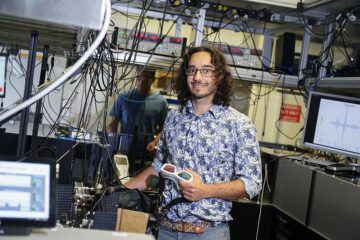Jefferson Alzheimer’s Vaccine Shows Promise in Animal Model

A new vaccine for Alzheimer’s disease created by researchers at the Farber Institute for Neurosciences at Thomas Jefferson University in Philadelphia has shown promise in initial testing in primates. Vaccinating the animals with beta-amyloid, the sticky protein substance that builds up in the Alzheimer’s brain that is thought to play a major role in destroying nerve cells and in cognitive and behavioral problems associated with the disease, resulted in a significant increase in plaque-clearing antibodies circulating in the bloodstream.
Scientists, led by Farber Institute for Neurosciences director Sam Gandy, M.D., Ph.D., report their results in the March 2004 issue of the journal Alzheimer Disease and Associated Disorders.
While a mouse model of Alzheimer’s is well established, researchers have run into problems in developing a human vaccine. In earlier human trials, a small group of patients developed encephalitis, or brain inflammation, from an immune response gone awry. “It would be invaluable to have a better model of Alzheimer’s that is closer physically and genetically to humans,” says Dr. Gandy, who is also professor of neurology, and biochemistry and molecular pharmacology at Jefferson Medical College and vice chair of the National Medical and Scientific Advisory Council of the Alzheimer’s Association.
Dr. Gandy and his colleagues tested the vaccine in four aged rhesus monkeys. Two monkeys were given beta-amyloid; the other two were given a placebo. Aging non-human primates develop some plaque, though less than a person with Alzheimer’s, Dr. Gandy says.
The vaccinated monkeys developed high levels of antibodies to beta-amyloid, while the circulating amyloid levels in the vaccinated monkeys increased five-to-10 fold, nearly all of which was bound to antibodies and cleared out. The two control monkeys vaccinated with a placebo had much lower circulating beta-amyloid levels.
“The amyloid in the brain seemed to be bound up to antibodies in the blood and cleared away,” Dr. Gandy says. “We’re clearly mimicking the biochemistry in the monkey that we have seen in mice. Vaccinating with amyloid brings an immune response that stimulates removal of amyloid from the body.”
“The animal model described in this study expands the way we might evaluate new vaccine products,” says William Thies, Ph.D., Alzheimer’s Association vice president for medical and scientific affairs.
There was no evidence of inflammation in the monkey brains six months later.
According to Dr. Gandy, researchers in the late 1990s created a transgenic Alzheimer’s mouse with human genes. They vaccinated the mice with beta-amyloid and found a dramatic clearing of the amyloid plaques. They also found they could prevent plaque formation if they began vaccinating before plaques formed, and could reduce plaque formation if the vaccine was given early in their development. In addition, the researchers found they could also take serum from vaccinated mice, put it in unvaccinated mice and stimulate clearance of plaques.
But in a subsequent clinical trial of 300 patients, 15 developed encephalitis, or inflammation of the brain, from an immune reaction in the brain. “The individuals developed antibodies that caused excessive brain inflammation in being drawn to the amyloid plaques and activating clearing from the brain – the inflammatory response was out of control,” says Dr. Gandy.
“We’d like to dissociate the good part of the immune response from the bad part,” Dr. Gandy says.
Dr. Gandy notes that a cellular response by T-cells – and not the antibodies – could have caused the encephalitis. “It might be possible to design a different vaccine or design synthetic antibodies to avoid the encephalitis problem,” he says.
Dr. Gandy and his team currently are working with the Yerkes National Primate Research Center at Emory University in Atlanta to develop a primate model of plaque formation. Such a model also provides a more “useful model of cognitive decline,” he says, noting the mouse’s “behavioral repertoire is limited.”
While the model will provide a model for pathology and behavioral aspects of Alzheimer’s, he says, it may also be useful to examine any cases of encephalitis that might develop.
Researchers from Washington University in St. Louis, Harvard University, the University of Zurich, the Institute for Advanced Studies in Aging and Geriatric Medicine in Washington, D.C., the University of Michigan, the University of Toronto and the Yerkes National Primate Research Center also collaborated on the work.
Media Contact
Weitere Informationen:
http://www.jeffersonhospital.org/news/e3front.dll?durki=17562Alle Nachrichten aus der Kategorie: Medizin Gesundheit
Dieser Fachbereich fasst die Vielzahl der medizinischen Fachrichtungen aus dem Bereich der Humanmedizin zusammen.
Unter anderem finden Sie hier Berichte aus den Teilbereichen: Anästhesiologie, Anatomie, Chirurgie, Humangenetik, Hygiene und Umweltmedizin, Innere Medizin, Neurologie, Pharmakologie, Physiologie, Urologie oder Zahnmedizin.
Neueste Beiträge

Neue universelle lichtbasierte Technik zur Kontrolle der Talpolarisation
Ein internationales Forscherteam berichtet in Nature über eine neue Methode, mit der zum ersten Mal die Talpolarisation in zentrosymmetrischen Bulk-Materialien auf eine nicht materialspezifische Weise erreicht wird. Diese „universelle Technik“…

Tumorzellen hebeln das Immunsystem früh aus
Neu entdeckter Mechanismus könnte Krebs-Immuntherapien deutlich verbessern. Tumore verhindern aktiv, dass sich Immunantworten durch sogenannte zytotoxische T-Zellen bilden, die den Krebs bekämpfen könnten. Wie das genau geschieht, beschreiben jetzt erstmals…

Immunzellen in den Startlöchern: „Allzeit bereit“ ist harte Arbeit
Wenn Krankheitserreger in den Körper eindringen, muss das Immunsystem sofort reagieren und eine Infektion verhindern oder eindämmen. Doch wie halten sich unsere Abwehrzellen bereit, wenn kein Angreifer in Sicht ist?…





















